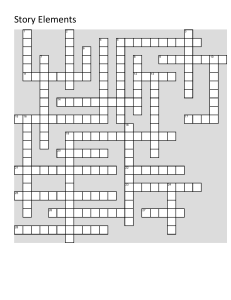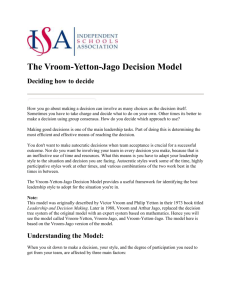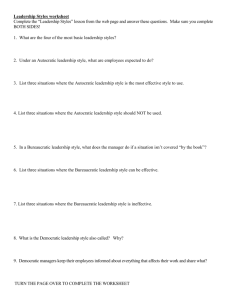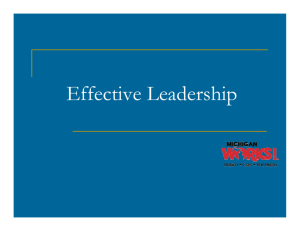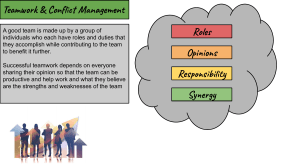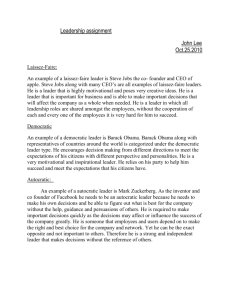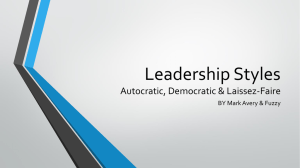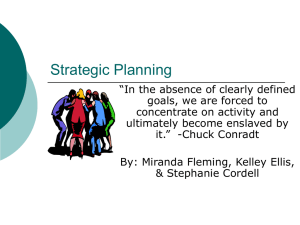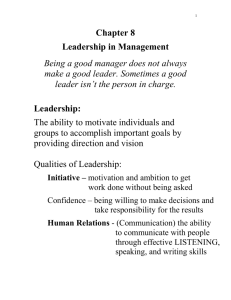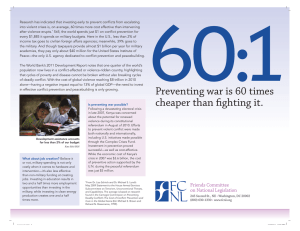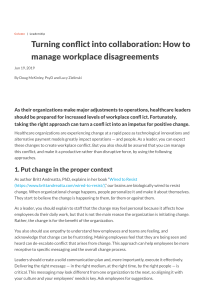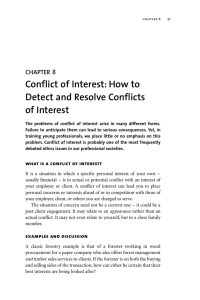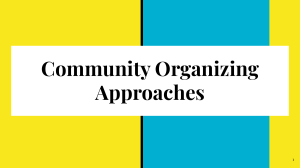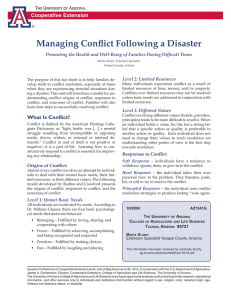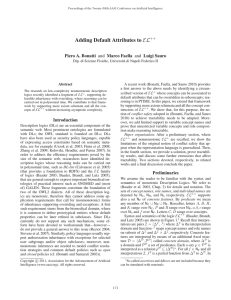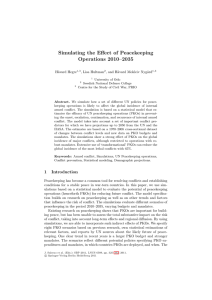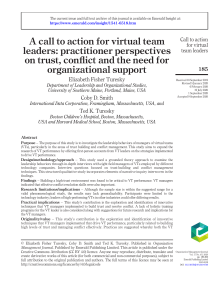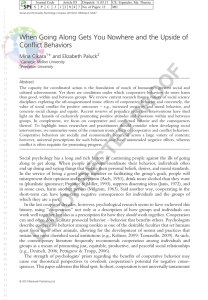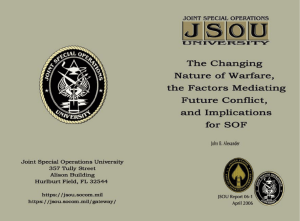What is then Leadership? W1: Introducaon
advertisement
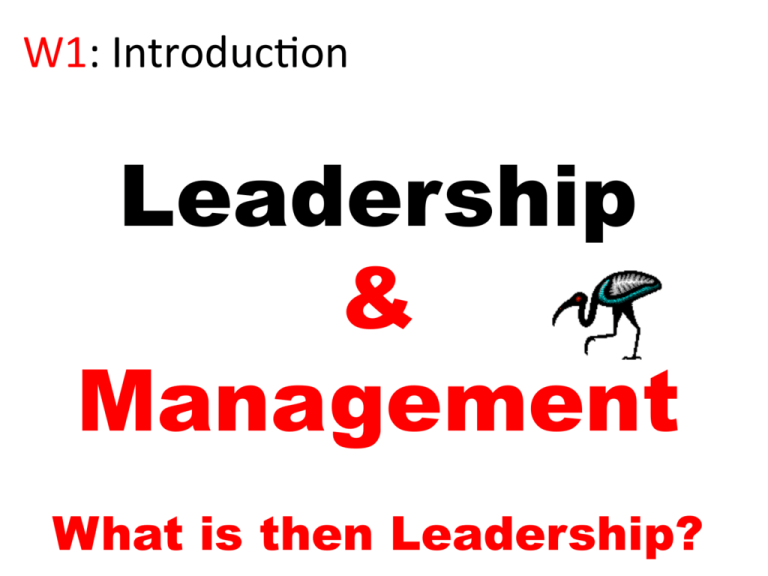
W1:Introduc-on Leadership & Management What is then Leadership? ☀TheEvolu-onofLeadershipResearch 1900: Traits approaches 1950: Behavioral theories 1990s 1960: Contingency theories Conflict • • • • Ppaper Construc-veConflict Difference,notwarfare Differencesinopinionsandinterests Cannotavoidconflictinorganiza-ons Managingconflict:putconflicttouse • Dominance:onesidewinsovertheother • Compromise:eachsidegivesupsomethingtoseEleanissue • Integra4onofdesires:Solu-onfullymeetsgoalsofeachparty.Neither partygivesupanything:Integra-ondiscoverssomethingnew; compromiseusesonlywhatexists Leadership Prevailingviewofleadershipwasbasedondominanceandaggression[P] Offeredanalterna-veviewofleadershipwithmanyposi-vequali-es[E] Ac-on-orientedpersonclearlyfocusedonthefuture[A] Avisionofthefuture.Decisionsmadewithanunderstandingoftheirlongtermeffects[K] ☀W2.Again:Whatisleadership? HR&SWOT-strategiesWhereisPEAK? ☀YuklMul-pleLincageModel ☀The Hershey and Blanchard Model The Hersey and Blanchard model of leadership identifies different combinations of leadership presumed to work best with different levels of organizational maturity on the part of followers. • Maturityleveloffollowerplaysanimportantrole • JobMaturity–(task-relatedabili-es) • Psychologicalmaturity(confidence,willingness,mo-va-on) Job_Maturity 1:LowJMLowPM:Telling 2:LowJM,HighPM:Selling 3:HighJM,LowPM:Par-cipa-ng 4:HighJM,HighPM:Delega-ng ☀Hersey-Blanchard Situational Leadership Model Leader s concern with task Low High High Leader s concern with relationship Low Mature Employees Willing/Able Unwilling/able Willing/unable Unwilling/unable 4 3 2 1 Immature Employees ☀Norma-veTheoryofLeadership:The VroomYetton-Jago Model • Vroom&YeEon(1973) – Leadershipbehavioursisdescribedthroughpar-cipa-on – Leadershipisdecision-making – Effec-vedecisionsarejudgedthrough:QAT[Quality.Acceptance&Time] • The Vroom-Yetton-Jago model of leadership attempts to prescribe the type of decision-making style that a manager should use given a particular situation. • The model requires the use of a decision tree. The decision tree assesses the situation in terms of several factors. • Based on the results of the decision tree analysis, the manager is advised to employ one of five leadership styles, ranging from making the decision alone to meeting with subordinates to make a group decision. • A key component of the model is determining how much to involve subordinates in making decisions. ☀Vroom-Jago-YeEonModel ü ü ü ü Determine appropriate level of involvement Practical assessing of the situation Five styles of Leadership Three types of leadership: Autocratic. Consultative. Group AI - Autocratic Solve the problem yourself using the information you have AII - Less autocratic Obtain the needed information from employees, then solve the problem yourself. Employees provide information but not alternatives. AIII - Consultative Share the problem with employees individually (but not as a group), seeking suggestions & possible alternatives. Solve the problem yourself. CII - More Consultative Share the problem with employees as a group, seeking suggestions & possible alternatives. Solve yourself. GII - Group Decision Share the problem with employees as a group, seeking suggestions & possible alternatives. Attempt to reach a consensus & be willing to accept & implement the employee’s solution. ☀Vroom&YeEon The leader adopts the appropriate decision by applying 7 rules: 1) Leader information Rule 2) Goal Congruence Rule 3) Unstructured Problem Rule 4) Acceptance Rule 5) Conflict Rule 6) Fairness Rule 7) Acceptance Priority Rule ☀CountryCulture • Countryculturedimensionsthatimplyacceptable managementbehaviourandorganiza-onalforms • Fivedimensions – Powerdistance – Uncertaintyavoidance – Individualism – Masculinity – Long-termorienta-on • Autocratic styles tend to work best in High Power-Distance countries, and • Participative styles in Low Power-Distance countries ☀Transac-onal&Transforma-onalLeadership It is based on a model by Burne, Bass, Avolis where 7 leaders factors are divided between: - transformational, - transactional and - non-leadership categories As a transactional leader, I use formal rewards & punishments. managing Contingent Reward. Management by Exception. Laissez-Faire Traditional Style of Leadership vision As a transformational leader, I inspire and excite followers to high levels of performance. Charisma. Inspiration. Vision Twotransac-onalfactors&onenon-leadershipfactor : 1. Charisma: Charismatic leader-manager sets high standards and challenges the staff to go beyond their usual level of effort. 2. Inspirational motivation: The leader-manager shares a vision with the staff that appeals to both their emotions and ideals. 3. Intellectual stimulation: The leader-manager stimulates followers to question the status quo, to think critically about what they are doing and why. 4. Individualized consideration: The uniqueness of each employee is recognized and assignments are based on ability and needs. 5. Contingent reward: Rewards match the employee's achievements. The leadermanager emphasize mutual agreement on goals. 6. Management by exception: The leader-manager using management by exception reacts when a problem occurs, uses more negative feedback than positive and is relatively punitive rather than facilitative in approaching the staff. However, the effective leader-manager limits the number of times he or she uses management by exception. 7. Laissez-faire: Another negative characteristic, a laissez-faire approach can most simply be described as the absence of leadership. Questions: • What do the authors borrow from early leadership theories? ☀Maslow s Hierarchy of Needs Selfactualization Esteem Belongingness and love Safety Physiological Organization: actors, responsibility and process Process of Decision Making [Responsibility for Steering ], Process of Communication [Responsibility for Employees] Process of Production [Responsibility for Efficiency and quality] Process of Innovation [Responsibiliy for Change] Leadership Input & demand Objectives & plans Supporting group Empowerment & commitment Distribution System Outcome & accept Development Output [efficiency]
